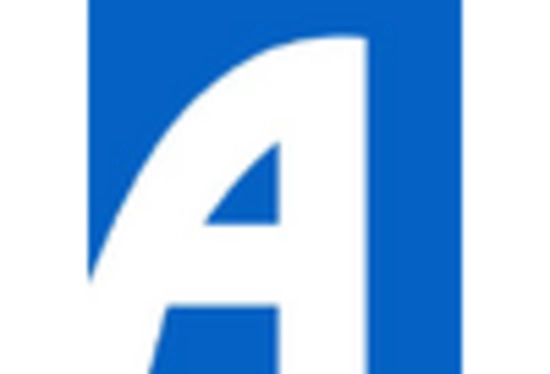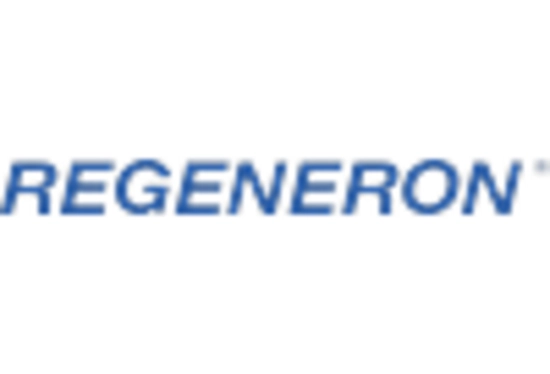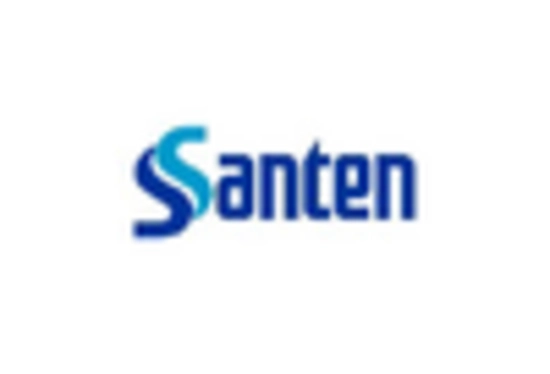Increasing Prevalence of Ocular Inflammation
The rising incidence of ocular inflammation conditions, such as uveitis and scleritis, is a primary driver for the Ocular Inflammation Treatment Market. Studies indicate that uveitis affects approximately 38 to 56 individuals per 100,000 people annually, leading to significant healthcare burdens. This increasing prevalence necessitates the development and availability of effective treatment options, thereby propelling market growth. As more individuals seek medical attention for these conditions, the demand for innovative therapies and medications is likely to rise. Furthermore, the aging population, which is more susceptible to ocular diseases, contributes to this trend. Consequently, the Ocular Inflammation Treatment Market is expected to expand as healthcare providers focus on addressing the needs of this growing patient demographic.
Growing Investment in Research and Development
The surge in investment in research and development (R&D) within the pharmaceutical sector is a crucial driver for the Ocular Inflammation Treatment Market. Companies are increasingly allocating resources to discover novel therapeutic agents and improve existing treatments for ocular inflammation. This trend is evidenced by the growing number of clinical trials focused on innovative therapies, including biologics and small molecules. According to recent data, the R&D expenditure in the ophthalmology sector has seen a notable increase, reflecting the industry's commitment to addressing unmet medical needs. As new treatments emerge from these investments, the Ocular Inflammation Treatment Market is likely to experience significant growth, driven by the introduction of more effective and targeted therapies.
Rising Awareness and Education on Ocular Health
Increased awareness and education regarding ocular health are pivotal in driving the Ocular Inflammation Treatment Market. Public health campaigns and initiatives aimed at educating individuals about the symptoms and risks associated with ocular inflammation have led to earlier diagnosis and treatment. This heightened awareness encourages patients to seek medical advice promptly, thereby increasing the demand for ocular inflammation treatments. Moreover, healthcare professionals are becoming more adept at recognizing and managing these conditions, further contributing to market growth. The emphasis on preventive care and regular eye examinations is likely to foster a culture of proactive health management, which could lead to a sustained increase in the Ocular Inflammation Treatment Market.
Regulatory Support and Approval for New Treatments
Regulatory support and streamlined approval processes for new ocular inflammation treatments are vital factors influencing the Ocular Inflammation Treatment Market. Regulatory agencies are increasingly recognizing the need for expedited pathways for innovative therapies that address critical health issues. This support facilitates quicker access to new treatments for patients suffering from ocular inflammation. For instance, the designation of breakthrough therapy status for certain investigational drugs can significantly reduce the time to market. As a result, pharmaceutical companies are more inclined to invest in the development of new therapies, knowing that regulatory hurdles may be less daunting. This trend is expected to bolster the Ocular Inflammation Treatment Market, as more effective treatments become available to meet patient needs.
Technological Advancements in Treatment Modalities
Technological innovations in treatment modalities are significantly influencing the Ocular Inflammation Treatment Market. The introduction of advanced drug delivery systems, such as sustained-release implants and nanotechnology-based therapies, enhances the efficacy and safety of ocular treatments. For instance, the development of corticosteroid implants has shown promising results in managing inflammation with reduced systemic side effects. Additionally, the integration of telemedicine and digital health solutions allows for better patient monitoring and adherence to treatment regimens. These advancements not only improve patient outcomes but also attract investments from pharmaceutical companies looking to capitalize on emerging technologies. As a result, the Ocular Inflammation Treatment Market is poised for growth, driven by the continuous evolution of treatment options.


















Leave a Comment